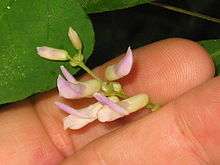Amphicarpaea bracteata
| Hog-peanut | |
|---|---|
 | |
| Inflorescence | |
| Scientific classification | |
| Kingdom: | Plantae |
| Clade: | Angiosperms |
| Clade: | Eudicots |
| Clade: | Rosids |
| Order: | Fabales |
| Family: | Fabaceae |
| Genus: | Amphicarpaea |
| Species: | A. bracteata |
| Binomial name | |
| Amphicarpaea bracteata (L.) Fernald | |
| Synonyms[1] | |
Amphicarpaea bracteata (hog-peanut or ground bean) is an annual to perennial vine in the legume family, native to woodland, thickets, and moist slopes in eastern North America.[2]
Description
Leaves have three leaflets and are held alternately on twining stems.
Flowers are pink to white and bloom from late summer to autumn. The flowers are either open for cross-pollination or closed and self-pollinating. The closed flowers may be above or below ground.[3]
Seeds from open flowers are held in a flat pod, pointed at both ends, that dries when mature and twists to release the seeds. Seeds from closed flowers are held in round pods with a single seed each. The roots and seeds are edible.[4] The seeds which become subterranean from flowers on stolons give it the name peanut.[5]
References
- ↑ "Amphicarpaea bracteata (L.) Fernald". International Legume Database & Information Service (ILDIS) – via The Plant List.
- ↑ "Amphicarpaea bracteata". Natural Resources Conservation Service PLANTS Database. USDA.
- ↑ Trapp, E. Joseph; Hendrix, Stephen D. (March 1988), "Consequences of a mixed reproductive system in the hog peanut, Amphicarpaea bracteata, (Fabaceae)", Oecologia, 75 (2): 285–290, doi:10.1007/BF00378611, ISSN 1432-1939
- ↑ "Amphicarpaea bracteata". Plants for a Future.
- ↑ Hilty, John (2016). "Hog Peanut (Amphicarpaea bracteata)". Illinois Wildflowers.
External links
| Wikimedia Commons has media related to Amphicarpaea bracteata. |
| Wikispecies has information related to Amphicarpaea bracteata |
- Native Plant Database profile, Lady Bird Johnson Wildflower Center, University of Texas at Austin
- Connecticut Plants, Connecticut Botanical Society
- Missouri Plants
- Flora of Wisconsin, Wisconsin State Herbarium, University of Wisconsin–Madison
- Amphicarpaea bracteata in the CalPhotos Photo Database, University of California, Berkeley